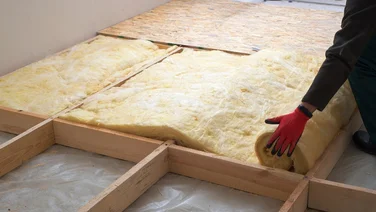- According to Euromonitor, cost is the primary obstacle to sustainable purchases for 41% of consumers
- In 2024, 58% of all UK adults switched to energy saving lightbulbs
- From 2013-2024, 4.5 million energy efficiency measures were installed in 2.8 million properties in the UK

Installing renewable energy technology is the best way to save money on your bills and cut down your carbon emissions.
While there are government grants for solar panels and other technology, the upfront cost can still be a big barrier.
The fact is choosing to install a solar panel system or replace your gas boiler with a heat pump can sometimes mean shelling out a lot of cash.
Statistics from the Department for Energy Security and Net Zero (DESNZ) Public Attitudes Tracker shows that in winter of 2024, only 23% of respondents were very/ fairly likely to install an air source heat pump, with 50% of respondents citing the common barrier as cost.
But the good news is this: you don’t need to spend a fortune to cut down energy bills and carbon emissions. In fact, there are loads of ways you can cut your carbon footprint and save yourself money without spending a lot.
In this guide we’ll take you through the small and cheap changes you can make around the house to start your eco journey, without forking out thousands.
However, if you are interested in installing solar panels, we can help. Just fill in our quick form and our trusted installers will reach out to you with free quotes for you to compare.
Low-cost solar alternatives
The Federation of Master Builders says that as of September 2025, a 4.5kW solar system on an average three bedroom house in the UK costs around £9,800.
Government grants for solar panels, such as the ECO4 scheme, can help, but it’s still a hefty upfront cost.
However, don’t think that installing rooftop solar is the only way forward because there are plenty of alternatives. Here are a few affordable solar-powered items that can help you save energy and reduce your carbon footprint without needing a big budget.
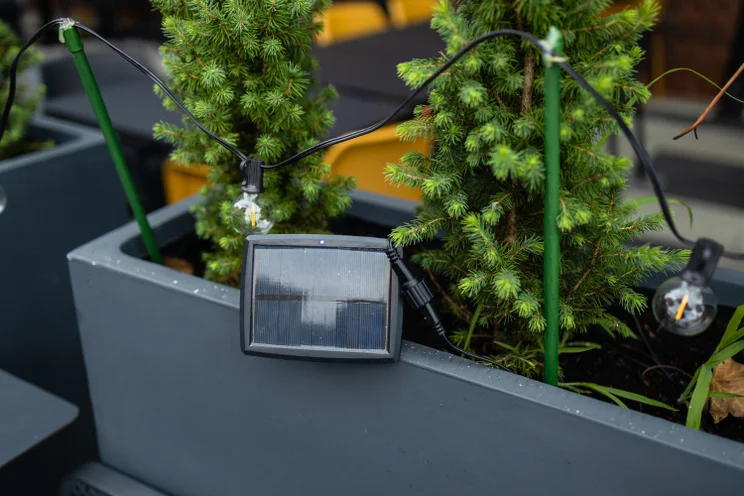
Solar lights
Lighting may not be the biggest energy drain but a few outdoor lights can quietly add to your bills. A standard mains-powered outdoor light using a 10W LED bulb could cost around 5p per night if left on for five hours, adding up to £18 annually per light.
Solar lights are an affordable, one-time investment for lighting driveways, balconies, or garden paths. A basic set starts from £10, with options including string lights, floor lamps or wall-mounted fixtures. They charge during the day and automatically switch on at dusk, providing light exactly when needed.
You could see savings in less than a year, particularly if you’re replacing multiple plug-in or battery-operated lamps.
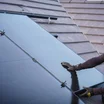
Get free solar panel quotes
Answer a few quick questions, and our trusted installers will send you bespoke solar panel quotes – for free.
Motion sensor lights
According to our research, security lights can cost £15–£40 per year if triggered frequently and even more so if you have multiple installations.
For a more sustainable and intelligent lighting solution, consider solar-powered motion sensor lights. Similar to standard solar lights, they charge during the day and activate only when motion is detected at night, starting from approximately £20. Certain models also offer adjustable brightness and detection range.
With no running costs and minimal maintenance, the motion sensor lights pay for themselves, boosting security and cutting your carbon footprint all at once.
Solar power banks and window chargers
Solar power banks or window-mounted solar chargers offer a free, renewable solution for charging phones, tablets, and even laptops.
The devices are compact and universally compatible. They charge via sunlight or USB backup and store power when you need it, meaning you don’t have to rely as heavily on using electricity from the grid. It’s also a smart backup to have during a powercut.
Charging times vary from a few hours to several days, depending on factors such as battery size and solar panel wattage. A wide range of options are available to suit any budget.
Solar-powered fans
In the UK, running a fan typically costs between 63p per week if you have it on for nine hours nightly. While this may seem insignificant, continuously operating a standard 20-50W desk fan could cost approximately £2.52 per month, or £32.76 annually.
A solar-powered fan can cost as little as £5, or around £20 for a higher-quality model. Regardless of the initial price, a solar-powered fan would generate savings within a year compared to an electric fan.
Off-grid gear
In the event of a power cut, solar-powered essentials can be a smart and reliable investment, especially in case of an emergency.
Options include solar flashlights, headlamps, compact solar panels and emergency radios with a hand crank or USB charging for those nifty solar power banks. When looking online, prices start from around £15.
These items can be charged by sunlight or stored solar power, offering zero running costs and longevity. They provide a continuous source of light, power, and communication without requiring an electrical outlet.

Get free solar panel quotes
Answer a few quick questions, and our trusted installers will send you bespoke solar panel quotes – for free.
Low-cost insulation & double glazing alternatives
Having a well insulated house is of the utmost importance when it comes to saving money on your energy bills.
The English Housing Survey (EHS) reported that in 2023, 52% of homes were at EPC D or below. While still a significant success compared to the 19.3% in 2012, a 2024 study conducted by EDF Energy and property platform Sprift, suggests that 41%, or 6,291,448 households are living with insulation standards dating back to 1976.
With that being said, it’s likely that your property could do with some insulation upgrades. Insulation in itself is one of the cheapest ways to increase your properties energy efficiency, but if you’re looking for a little extra to keep your home as warm as possible, there are some more tactics to consider below.
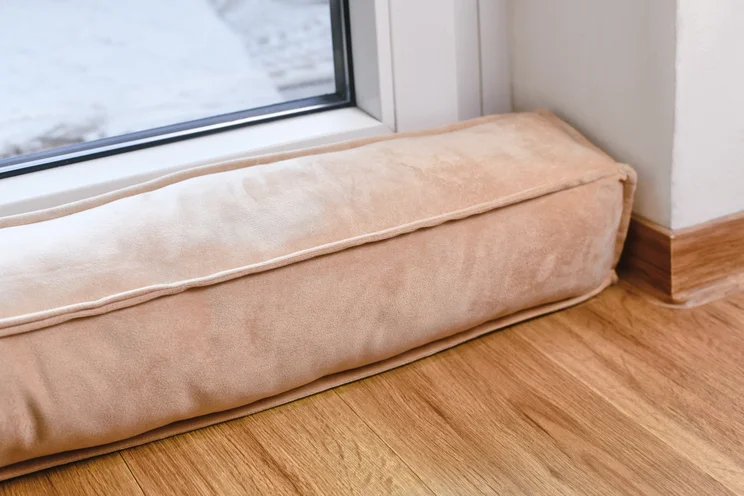
Draught excluders
Unless you have insulation, double glazed doors and double glazed windows, it’s possible your home is losing heat from somewhere, and even then, there might still be some pesky gaps. The most likely culprit? Heat escaping from under doors and around windows.
Draught excluders, also known as door snakes, are snake-like bundles of material designed to prevent air escaping from your home. They are simple to install: just place them at the base of doors or on window sills to block cold air. They are available from £5, or you can create your own using old socks and fabric.
Research suggests that air infiltration through a sash window can be reduced by as much as 86% by adding draught-proofing, helping your home stay warmer for longer without turning up the heating.

Get free double glazing quotes
Answer a few quick questions, and our trusted installers will send you bespoke double glazing quotes – for free.
Window film insulation
Inefficient windows, such as single-glazed, uPVC or older models, significantly contribute to heat loss and increased energy expenses. Window film insulation offers a rapid, cost-effective alternative to traditional double glazing.
A window film insulation kit, which we calculated is typically priced between £10 and £20, can insulate multiple windows. The film is applied with double-sided tape and then gently heated to tighten it, forming a transparent layer that retains warmth and prevents drafts.
An additional benefit is that window film insulation is removable, making it perfect for renters or those in listed buildings.
Thermal curtains and linings
As we’ve said before, windows are a major source of heat loss, but thermal curtains offer an effective solution to retain warm air indoors. While a pair typically costs £20-£40 as per our research, adding thermal linings to existing curtains can reduce this expense.
These curtains are beneficial year-round, blocking heat in summer and reducing heat loss by up to 25% in winter. They are particularly effective on large windows and patio doors and offer a more aesthetically pleasing option than some alternatives.
Rugs and mats
Rugs and mats offer a simple yet effective way to improve a room’s thermal comfort and energy efficiency. By insulating cold floors, they reduce heat loss and heat costs while making spaces feel warmer and more inviting.
Beyond practicality, the aesthetics of rugs outmatch those of window film insulation, for example. They add texture, colour and coziness as an affordable solution that provides both tangible energy savings and an elevated living experience.
Silicone sealant
Similarly to window film insulation, silicone sealant offers a cost-effective solution for sealing small cracks and gaps around windows, doors, skirting boards, and floor edges. A significant advantage of silicone sealant is its long-lasting application, which can last for years and be redone with ease.
A tube of silicone sealant typically costs between £5 and £10 and can be applied using a caulking gun or squeeze tube. The benefits include a warmer, quieter, and more energy-efficient home, leading to reduced heat loss and lower energy bills.

Get free insulation quotes
Answer a few quick questions, and our trusted installers will send you bespoke insulation quotes – for free.
Low-cost heating alternatives
According to Deloitte’s 2024 The Sustainable Consumer report, most people say they want to be eco-friendly, with 51% saying so. Yet, only 6% said they had replaced their gas boiler with a heat pump and just 10% said they were planning to do so.
The UK government has plans to install 600,000 heat pumps per year by 2028, but despite encouraging progress, the total number of heat pump sales both supported and separated from government programmes was just below 100,000 in 2024.
The Boiler Upgrade Scheme means now is a great time to do it. In the meantime, here are some low-cost heating alternatives.
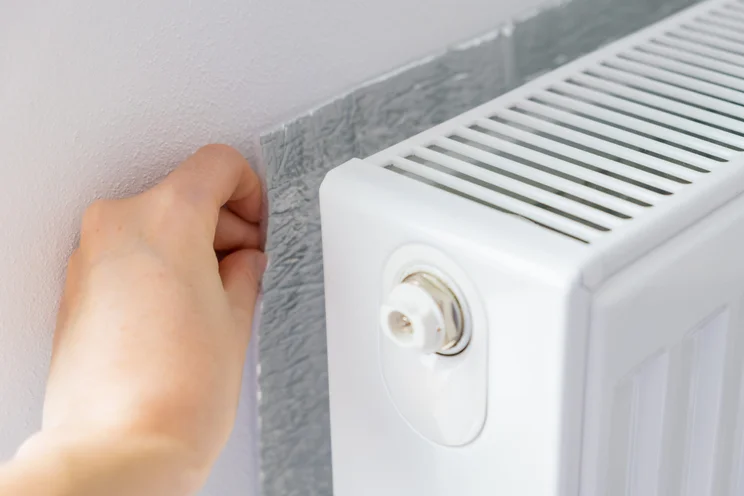
Reflective radiator panels
External wall mounted radiators lose a surprising amount of heat through the wall itself. Reflective radiator panels are a pretty hassle-free solution to this problem as they can bounce up to 95% of the heat from the radiator back into the room.
These radiator panels are a highly economical investment, with a roll costing as little as £7 from our vague research. Installation is straightforward and requires no special tools or professional assistance. The panels can be easily cut to size, guaranteeing a perfect fit behind any radiator. By reflecting heat back into the living space, these panels dramatically reduce heat loss, contributing to a warmer home and lower energy bills.
Green energy supplier
One of the simplest ways to reduce your household’s carbon footprint is by opting for a green energy provider. These suppliers get their electricity from sustainable sources like offshore wind turbines, solar farms, and hydroelectric power plants.
Many green energy tariffs are now competitively priced, meaning you might pay the same or even less than with traditional fossil fuel suppliers. Additionally, some providers offer benefits like carbon offsetting, energy usage tracking, or support for community energy projects.
The transition process is typically quick and straightforward. You will continue to receive electricity through the existing grid, but it will come from cleaner sources. This change directly helps combat climate change.
Off peak energy
According to Harvard Business Review, 33% of all UK adults in 2024 switched energy consumption around the home to off peak times.
You can save money on your electricity bills by shifting the use of heating or high-energy appliances to overnight or early morning. This is especially beneficial if you are on a time-of-use tariff or a smart energy plan, as demand is lower and rates are cheaper.
If you’re not currently on a time-of-use tariff, it’s worth checking with your supplier. Some green or smart energy plans offer off-peak pricing that could make switching a smart financial decision and help ease pressure on the energy grid.
Radiators
Heating an entire home when only a few rooms are in use wastes both energy and money. A simple solution is to turn off radiators in infrequently used areas, such as spare bedrooms or storage spaces.
This quick action can reduce heating bills by 10-20%, particularly during colder months. Keeping doors closed will prevent warm air from escaping into these unused areas.
Combining this habit with reflective radiator panels will maximize warmth in the rooms you regularly use. It’s an easy way to conserve energy without compromising comfort.
Infrared heaters
Infrared heating panels offer an efficient and modern alternative to traditional heating methods. These sleek panels directly heat people and objects, rather than the air, resulting in quicker, cleaner, and more efficient warmth.
Starting from approximately £150–£300 each, these panels are pricier than other methods listed, but are still a cost-effective solution compared to a heat pump. Installation is flexible, allowing for wall or ceiling mounting, they require no pipes, and they’re silent.
Overall, infrared heating panels consume less energy, and their direct heating approach means you feel warmer faster, reducing overall power consumption.

Get free heat pump quotes
Answer a few quick questions, and our trusted installers will send you bespoke heat pump quotes – for free.
The Action Wheel
These changes might seem pretty trivial but the pennies add up over time and it’s easy to track your progress using a smart meter. There is no upfront cost to installation as energy suppliers are obliged to offer everyone in the UK a smart meter at no extra cost.
But if you’re looking to take your eco-conscious living to the next level, take a look at the low carbon lifestyles wheel (The Action Wheel). It covers a variety of changes you can make at home, but also actions you can take with transportation, diet and purchases.
Check out our Positive Energy Podcast where we talk to Lucy Shea, the CEO of Futerra, who, alongside BEWorks and the World Business Council for Sustainable Development (WBCSD), pioneered the Action Wheel.
How can I cut my bills long term?
The ideas suggested above will help you kickstart your journey to living a low-carbon lifestyle. However, in order to see maximum bill savings, we would recommend installing renewable technologies such as insulation, solar panels and heat pumps.
By taking advantage of government grants and schemes, you could soon be seeing huge savings on your electricity bills. Take a look at our informative pages where we make suggestions about how to spend less on your energy bills, in order to make informed decisions on your next green tech purchase.
Summary
- Investing in renewable energy seems daunting, but it doesn’t have to be expensive. There are plenty of products designed to make home living a bit more eco-friendly, without breaking the bank.
- Using a solar power bank, making a draught excluder and switching to off-peak energy usage are just a few of the many ways you can save money on your bills.
- For those looking to make the most of renewable technology, it is worth replacing your boiler with a heat pump and installing a solar panel system as well as making these small changes.
- Using The Action Wheel as a guide can help you practise sustainability in all areas of your life.





